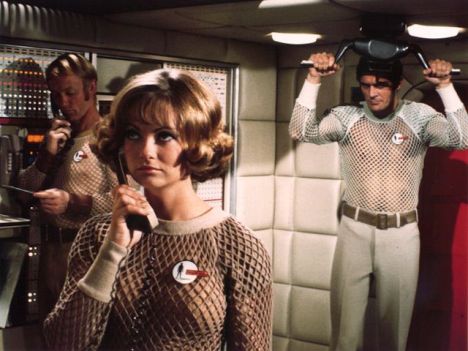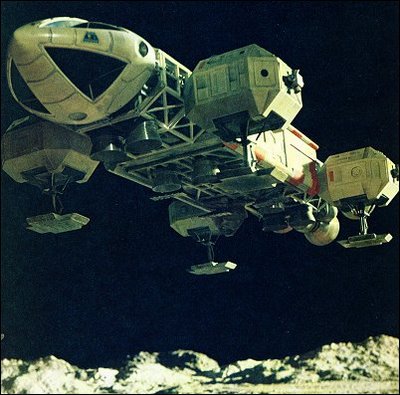
I bet many of you were expecting a breathless “Wow! Look at these!” post from me moments after the LRO images of the Apollo landing sites were revealed on Friday, eh? Well, it was a crazy day – what with work, then a funeral, and then an Outreach talk here in Kendal that night (which went very well, thank you to everyone who came along), I didn’t really have time, to be honest. And also, I wanted to pull my thoughts together and write something a little more – well, not meaningful, but considered and personal, you know?
But now, a couple of days after, things have calmed down a little and I obviously feel the need to comment on the amazing things NASA has shown us in the past couple of days – retouched video footage of the Apollo 11 moonwalk, and images of the Apollo landing sites taken by the Lunar Reconnaissance Orbiter.
I must admit I was looking forward to the release of the “enhanced Apollo 11 footage” so much I had gotten myself so excited – almost giddy – that I felt like a fat kid locked overnight in a sweet shop. A few months ago, waiting for the images to appear would have involved sitting here and constantly refreshing the NASA homepage until the news release appeared. But times have changed; I have come to realise, as I think a lot of space enthusiasts have, that Twitter is the best way to keep on top of space stories, because NASA and several other space-related agencies/companies/individuals post updates, alerts and press releases on there as fast as they can. So, here I sat, keeping a close eye on my Twitter page instead, waiting for the heavily-hyped “new footage” to be posted by NASA. When the notification came in that the footage was online I almost let out a silly yelp of delight! If the reports and rumours were right, then finally I was going to get to see Apollo 11’s moonwalk in startling detail! Hey! Maybe I’d see Armstrong’s face in the visor as he descended The Ladder and stepped onto the surface too?!? Lemme see, lemme see..!
<click> ( watches video clips… )
Ok… hmmm… that’s not quite as good as I expected, to be honest.
And, being totally honest, I was a bit disappointed at first. What had been knuckle-gnawingly grainy and blurry footage was now… well.. slightly less grainy and blurry. It was undoubtedly clearer, but, hand on my heart, the enhanced footage of Armstrong making his way down the ladder left me unmoved. We had gone from this…

… to this…

… which is a some improvement, definitely, but hardly jaw-dropping, to be honest. So yes, I was a little underwhelmed by that.
Then I saw the final clip, the footage of Armstrong and Aldrin setting up the flag, and my heart leapt. NOW we’re talking! We’ve only ever had this…

… and now we have this…

Now that’s a BIG improvement. I was a lot happier with that! And the good news is that the whole Apollo 11 moonwalk will have been reprocessed and retouched and enhanced within a couple of months and then we’ll see some really impressive stuff! 🙂
Something “interesting” came out at the media press conference held to herald the release of the “new Apollo footage”. It’s a very complicated story, and one that many people are very uncomfortable with and embarrassed about, but essentially it turns out that the original data tapes used to record and then store the Apollo 11 moonwalk on were later… um… erased, and effectively recycled, and used to store data of something else on. I know, I know, I shook my head in disbelief too, and believe me, I was all fired up to write a long, rambling, angry post about this monumental cock-up, but I think it speaks for itself. All I’ll say is this: taping over an episode of DR WHO – bad. Taping MATCH OF THE DAY over your wedding video – very bad. Erasing original footage of Mankind’s first ever expedition to another world – priceless.
I just hope that when the re-processing of thisApollo footage is completed, the film company doesn’t hand over the original master copies to NASA. If they do, then someone is bound to tape FAMILY GUY or LOST over them… 😉
But as impressive as it was, the enhanced footage of the Apollo 11 EVA was really just the warm up act for the Big One – the release of images of the Apollo landing sites taken by NASA’s recently-arrived Lunar Reconaissance Orbiter, or LRO.
In recent momths the speculation about these images has reached fever pitch, as people wonderde just how detailed they would be. There was a lot of hype and over-optimism. While people In The Know warned that the height of LRO and the resolvig power of its camera meant that the images would only show the descent stages of the lunar modules – and some of the scientific packages left on the Moon by the astronauts – as mere knots and clusters of pixels, other people enthusiastically predicted that we’d clearly see the lunar rovers and even the flags, too! I was pretty sure it was going to be the former, but of course I was secretly hoping that we’d see a little more than that… 😉
On the day of the release, last Friday, the schedule was pretty clear. NASA would release the images to the world at mid-day my time, and two hours later there would be a press conference for the media, at which experts would talk about the images and explain what they were showing. Because I was giving an outreach talk on Friday evening I knew I’d miss the conference, but thankfully I was going to be home at the time the images were released, so after getting back from work I settled myself down in front of the computer, logged on to Twitter, and waited.
As mid-day approached there was no sign of any Tweets alerting me that the images had been released, so I wandered back to my real online home, unmannedspaceflight.com, to hang out there and wait with my fellow UMSFers for the images to come in. I knew that, in this case, UMSF would be a safe bet for hearing about the images as soon as they hit the net because many of its members are absolutely rabid Apollo fans, and if anyone was going to track down the images, they were!
And I was right. At 12.10 my time, with no sign of anything official from NASA yet, UMSF member Phil Stooke, a hugely-respected planetary cartographer and image expert, posted a link to a story on Spaceref.com, which had the first LRO Apollo landing site image. It was only small, and tucked away down at the bottom, but there it was…!

Yes, there it was… Tranquility Base, seen from above, four decades after Eagle landed there and Mankind became, albeit briefly, a multi-planet species. Ten minutes later UMSF member Paolo alerted everyone that NASA had officially released the LRO images, and they were up on a NASA website. I clicked, and found myself staring at this…

Wow… wow… look at that! FOUR Apollo landing sites seen by LRO! And not only were the descent stages and their shadows clearly visible, but looking at the Apollo 17 image you couldn’t help thinking “Are those dark lines on the surface the tracks of the astronauts..?” Surely not, surely that was wishful thinking…
But no. It was real. And when the Apollo 14 landing site LRO image was posted, then things really kicked off…

That clinched it, it was there for everyone to see: the tracks of the moonwalking astronauts were definitely, 1000% there leading away from the lunar module. LRO had done it. It had shown us Apollo hardware – and the unmistakeable signs of human activity – on the Moon.
I must admit I was a little lost for words for a few moments. I’ve waited a long, long time to see those pictures, and finally I had them, on my screen, in my computer, and printing off on sheets of A4 beside me. “Historic” is a grossly over-used word, but these images truly are historic. They document nothing less than our species’ first tentative toes-in-the-water steps out into the universe.
I returned to the Apollo 11 image, wanting to relish every pixel. I also wanted to print out a good quality hard copy to put in a frame and take along to my outreach talk a couple of hours later. Here’s the official NASA image…

I had to do a zoom-in and tweak it a bit, didn’t I? When I did, I got this…

You can clearly see the Eagle’s descent stage dead centre, to the left of a small crater which is as far as Armstrong walked during his EVA. Beyond that small crater, to its right, you can also clearly see the much larger crater, surrounded by huge, scary-looking boulders. That’s the famous crater and boulder field that Armstrong had to steer Eagle away from during its descent. When you’re flying a spaceship with a hull barely thicker than a sheet of cooking foil the last thing you want to do is to come down on a boulder three times larger than you are…
While I was drooling over the Apollo 11 image, the members of UMSF who are good – no, great – at this kind of thing were busy working their magic on the LRO images, bringing out details not immediately obvious in them and also identifying features and landmarks on them. Space archaeology happening live, before my very eyes!
Scouring the image of the Apollo 16 landing site, “Charborob” managed to identify the location of “House Rock”, a huge boulder visited and studied by the astronauts. Here’s his crop of the image:

And here’s a screengrab from the Apollo 16 mission, showing House Rock and the astronauts beside it… look at the size of that thing…!

Meanwhile, Phil Stooke had been busy slaving away over the Apollo 17 landing site image, and had found the famous huge “Split Boulder” shown in this iconic Apollo image…

Phil’s detective work turned up this view of the famous boulder(s) on the Apollo 17 LRO image…

You can’t see any traces of astronaut footprints, but that’s still impressive work! 🙂
UMSF member Ian Regan was also having a field day, comparing the LRO images with frames he had grabbed from looking-down-thru-the-window camera taken from the lunar modules as they blasted off from the Moon’s surface at the end of their stays. This allowed him to match up features on the images and identify them. Here’s what he did for Apollo 15 (top =LRO, bottom = frame from onboard footage):

See those two arrows? The larger one is pointing to the lunar module’s descent stage. The smaller one, to the left is pointing to what Ian is pretty sure is a large piece of insulation material that blew off and away from the descent stage as the ascent stage lifted off. You can see it flapping and spinning away from the descent stage very clearly in the film taken at the time. Isn’t that amazing?!
Ian is also confident he’s identified the locations of three of the lunar rovers! They’re circled in red on this picture…

But it was the LRO image of the Apollo 14 landing site that was attracting the most attention on UMSF, and, by then, on Twitter and across the rest of the internet too. Because it clearly showed not just Apollo hardware, but dark lines, tracks, connecting and meandering between them…

Now that made me sit up and take notice, especially when Phil Stooke worked his magic and not just enhanced the image but labelled the things visible on it…

What do all those letters mean? Well, ALSEP stands for “Apollo Lunar Surface Experiment Package”, and basically every Apollo mission deployed an ALSEP on the Moon. Here’s Apollo 14’s ALSEP seen on the surface:

LRRR? What’s that? Ah, that stands for “Lunar Ranging Retroreflector”, and it’s one of the famous boxes covered in reflective panels deployed by the astronauts to allow scientists back on Earth to measure the distance to the Moon by bouncing laser beams off them. Here’s Apollo 14’s LRRR just after it was deployed…

Between the lunar module and the science packages you’ll see a mark labelled “Turtle Rock”. This is a large rock visited by the moonwalking astronauts as they explored their landing site. Here’s how it looked to the astronauts:

They’re all great catches, and show just how amazing the LRO images are. But the most important feature on the Apollo 14 LRO image is the scuffed-up ground connecting all the various rocks, science packages and craters… because those are tracks made in the lunar dust by the astronauts as they bounced and bounded across the surface during their moonwalk.
UMSF member jekbradbury cropped and enhanced the LRO image to show the astronauts’ tracks more clearly…

In fact, they’re not just tracks made by the bootys of Alan Shepherd and Stuart Roosa, they’re wheel tracks, too. Apollo 14 didn’t carry a lunar rover – the three missions that followed did – so to help them transport their equipment around the landing site, and bring their heavy rock samples back to the lunar module, the astronauts used a small, two-wheeled cart called the “Modularised Equipment Transporter”,or MET for short (oh, how NASA loves its acronyms!). Here’s an image of the MET on the surface…

You’re right – it’s basically a fancy wheelbarrow, stuffed full of Apollo kit. So, the LRO Apollo 14 image doesn’t just show the astronauts’ tracks, but also the wheel tracks of the MET.
But that makes this image – for me, at least – easily the second most thrilling LRO / landing site image after the Tranquility Base portrait, because it shows unmistakeable signs of human activity on the Moon. It is Important. I’d even compare it, in terms of importance and historical significance, to the trail of footprints left by our distant ancestors at Laetoli, Tanzania, preserved for the last 3.6 million years…

Here’s a lovely shot of the wheel tracks of Apollo 14’s MET, shining in the sunlight…

But back to The Image, that picture of the Apollo 11 landing site, the one we’ve waited to see for so, so long. That image is as important as… actually, I can’t think of one historical image that matches it. If Columbus had taken a picture of land on the horizon as he sighted the New World, that would have been an equivalent, perhaps? If Galileo had pointed a camera into the eyepiece of his telescope as he peered at the Moon and Jupiter for the first time, capturing that historic view, that might have been as important. But obviously we missed those photo opportunities! No. The LRO image of the Apollo 11 landing site is absolutely unique, because even if the images taken by LRO of the same site in the future are of better resolution – which we’re assured they will be – there will only ever be one First Photo of Tranquility Base from orbit, and this is it…

I showed the LRO pictures at my outreach talk on Friday night, and most – I can’t honestly say all – of the people there were very impressed. The print out of the LRO image I put in a frame was handed around, and looked at appreciatively, and several people there were genuinely impressed and moved by the sight of Eagle’s descent stage sitting there, on the Moon, 40 years after its crew blasted off back for home.
Looking at that image I can’t help wondering… what would it look like if we were actually standing there, on the Moon? Well, it would look a lot like this…

That’s the descent stage of the Apollo 16 lunar module, “Orion”. I’ve tweaked it a bit, but it’s a real picture. And the descent stage of Eagle, Apollo 11’s lunar module, will look exactly like that right now. Of course, there’d be some impiortant and historic pieces of equipment and Apollo artefacts scattered around it – the ground beneath the descent stage would be littered with discarded cannisters, containers and even bags of urine dumped out of the module before blast off. The famous flag would be there too, but probably lying on the ground, not standing up – footage taken during the Eagle’s ascent clearly show the flag being battered brutally by the downblast of the engine, and if it didn’t fall over completely the chances are it was left bent over at a crazy angle. There’d also be the Apollo 11 ALSEP and the tv camera Armstrong erected, too. Doug Ellison, the merciless ruler of unmannedspaceflight.com worked his computer magic to show what is where at Tranquility Base…

And that’s not just a map, oh no. Doug has simulated LRO’s view of the Apollo 11 landing site, with the lighting angle and orientation and everything else portrayed accurately, so what you’re seeing there is exactly what LRO saw, and what the image actually shows, too. Compare the two at a similar scale and you get…

How stunning is that? When I look at the two side by side, I can almost convince myself I can see structure within the LM’s shadow… almost! There’s no sign of the flag or tv camera or ALSEP, I don’t think… I can’t see them anyway… but maybe when LRO’s orbit drops, and it rephotographs the landing site at much better resolution they’ll pop into view. I hope so. But even if they don’t, we already have this fantastic image to treasure.
Seeing the new footage, and the LRO image, and following all these Apollo celebrations has put me in two minds, to be honest. I’m in a bit of turmoil here. Part of me wants to join in the party, to put on a silly hat, grab a can of beer and celebrate, rejoice at the incredible achievements of Apollo and honour not just Armstrong, Aldrin and Collins but all the tens – hundreds? – of thousands of people who stood behind them; the technicians, engineers, programmers and everyone else who enlisted or were drafted into the Silent Army of Apollo, the men and women who pushed that might Saturn V – and all the others – into orbit and beyond with the sheer power of their belief, dedication and passion…
… then there’s the other part of me, the spacesuited devil on my other shoulder that wants to scream “Noooo!!! You fools!!!” at my entire species for being so timid, so apathetic and so short-sighted. I’m so mad at Mankind because, after centuries of looking longingly and fearfully at the stars, we found the courage to leave home and reach the Moon, only to run home again with our tails between our legs, frightened by the immensity of the universe we suddenly found ourselves in, terrified by the emptiness we felt all around us Out There.
Goddamnit, I’m so mad at us that I wish I was “Q” from Star Trek: The Next Generation, then I would put Mankind on trial, before a jury of our baffled and ashamed descendants, and force us to defend charges of cowardice, timidity and apathy in the face of our destiny. I’d sit in that great Q throne, a sneer on my face, and, leaning forward contemptuously, say: “I put it to you, Humanity, that for a brief, shining, golden moment in the 20th century, you pulled yourselves up to your full height, stared the cosmos straight in the eye and said ‘Bring it on…’ … and then turned tail and fled, to huddle in the corner of your cave, hiding from the stars once again… How do you plead?”
Because we really shot ourselves in the foot with Apollo, didn’t we? We should have had a permanently-manned Moonbase by now. We should have had a scientific outpost on Mars too, where scientists from different countries would be working together to look for signs of life, past or present, on the Red Planet. We should have had not just one but several space stations, and regular and easy access to and between them via spaceplanes. Jeez, I should be sitting here, writing this, and be able to look up from my monitor and see a framed print of Christa McAuliffe posing beside Eagle’s descent stage – standing on the special transparent platform that covers the entire landing site, protecting Armstrong and Aldrin’s footprints – conducting the first teacher’s lesson from the surface of the Moon. And I should be able to go to YouTube and see footage of Miles O’Brien looking over the edge of Hadley Rille, shaking his head in disbelief and wonder…
How do you plead?
Guilty as charged, M’lud Q.
Ok, calm down. Take a deep breath. It’s been a crazy couple of days, hasn’t it?
What do these images actually mean? Well, the bottom line is, that’s it. See? Right there. The proof is there now. We have pictures of hardware and can even see tracks and trails of spacesuit boot-disturbed dust between them. As far as I’m concerned the game is over, and has been won. The people who believe the Moon landings were all a hox, and were faked, can now either accept that, and rejoin the rest of us here in the real world, or they can continue to don their silver foil hats and run around flapping their arms like crack-addicted chickens, insisting that they’re the only people in the world who know the truth. It’s their choice, plain and simple.
So, thank you NASA, and thank you LRO team. I used to try and reason with people who raised the Hoax issue during my Outreach talks here in the UK, you know, go through… again… the reasons why you can’t see stars in the sky above the moonwalking astronauts, explain yet again why the flag looks like that on the pics, but now, naaah, frak it, I’m just not going to bother anymore. From now on, each time I give an Outreach talk I’m going to take along some prints of these LRO pics, and if anyone suggests Apollo was fake I’m going to stop my talk, reach into my bag, pull out the pics, walk right up to them in the audience and hand them a picture, in front of everyone, and leave it at that.
I am a defender of free speech, but I’m not a defender of absolute bloody stupidity, especially when it infects and corrupts the minds and free-thinking of other people who read the web pages and blog posts of Apollo hoax believers and, mistakenly, assume they have a frakking clue what they’re on about.
So, at the risk of offending some people, for which I apologise in advance, I’m going to say what many… most… of you are thinking…
Moon Hoax Believers – STFU!!!!!
And if, having read this, any HBs out there have taken offence and are preparing to fire back a flaming, angry response, I’ll save you some time. I know exactly what you’re going to say, and trust me, I don’t care. You’ve lost. The argument has moved on. You guys are like the last few remaining dinosaurs which survived after the asteroid stuck: your world has changed, gone forever, and you can howl and roar at the sky in defiance and denial as much as you like, it doesn’t change the fact that the flames of reason are coming closer and closer and will soon engulf you, rendering you extinct. So, flame away. I will quickly skim your responses, laugh quietly, shake my head, and then go back to updating all my schools and community Outreach talks by inserting the LRO pics into the “Moon” sections of my Powerpoint presentations. Because soon I’ll stand up in front of a classroom of 7 and 8 year old kids, or a drafty church hall full of retired farmers, or a library full of young families, and show them just what we achieved when we dared to reach for the stars all those years ago.
And maybe, just maybe, having seen these LRO images of Tranquility Base, some of those people will look up at the sky as they leave my talk, and smile.
Filed under: Uncategorized | 11 Comments »


















































































